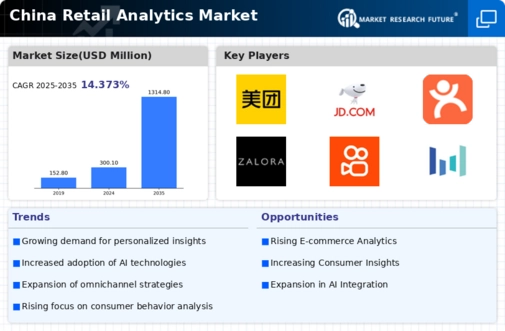Rising Consumer Expectations
The retail analytics market in China is experiencing a notable shift due to rising consumer expectations. As consumers become more discerning, they demand personalized shopping experiences and tailored product offerings. Retailers are increasingly leveraging analytics to understand consumer behavior and preferences, which is crucial for enhancing customer satisfaction. According to recent data, approximately 70% of consumers in China express a preference for personalized services, indicating a strong market demand. This trend compels retailers to invest in advanced analytics solutions to meet these expectations, thereby driving growth in the retail analytics market. The ability to analyze vast amounts of data allows retailers to anticipate trends and respond swiftly, which is essential in a competitive landscape. Consequently, the focus on consumer-centric strategies is likely to propel the retail analytics market forward.
Expansion of E-commerce Platforms
The rapid expansion of e-commerce platforms in China significantly influences the retail analytics market. With e-commerce sales projected to reach over $2 trillion by 2025, retailers are increasingly turning to analytics to optimize their online operations. This growth necessitates the use of sophisticated analytics tools to track consumer behavior, inventory levels, and sales performance across various channels. Retailers are utilizing data-driven insights to enhance their online presence and improve customer engagement. The integration of analytics into e-commerce strategies enables retailers to identify emerging trends and adapt their offerings accordingly. As a result, the retail analytics market is likely to see substantial growth, driven by the need for retailers to remain competitive in an ever-evolving digital landscape. The emphasis on data analytics is becoming a cornerstone for success in the booming e-commerce sector.
Emergence of Big Data Technologies
The emergence of big data technologies is significantly impacting the retail analytics market in China. With the proliferation of data generated from various sources, retailers are increasingly adopting big data analytics to gain actionable insights. This technology enables retailers to process vast amounts of information, including customer interactions, sales data, and market trends. As a result, retailers can make informed decisions that enhance operational efficiency and customer satisfaction. The retail analytics market is projected to grow as businesses recognize the value of big data in driving strategic initiatives. In 2025, it is anticipated that the adoption of big data analytics will increase by approximately 40%, reflecting a growing reliance on data-driven strategies. This trend underscores the importance of integrating advanced analytics into retail operations to remain competitive.
Shift Towards Data-Driven Decision Making
The shift towards data-driven decision making is a defining characteristic of the retail analytics market in China. Retailers are increasingly recognizing the importance of leveraging data to inform their strategies and operations. This trend is evident as businesses invest in analytics tools that provide insights into consumer behavior, sales performance, and market dynamics. The ability to make informed decisions based on data is becoming essential for retailers aiming to enhance their competitiveness. Recent studies indicate that companies utilizing data analytics are likely to experience a 20% increase in operational efficiency. This shift is driving the retail analytics market, as more retailers seek to adopt data-centric approaches to optimize their performance and respond effectively to market changes.
Government Support for Digital Transformation
Government initiatives aimed at promoting digital transformation in China are playing a pivotal role in the retail analytics market. Policies encouraging the adoption of technology in retail are fostering an environment conducive to innovation. The Chinese government has allocated substantial funding to support digital infrastructure, which is essential for the implementation of advanced analytics solutions. This support is reflected in the increasing number of retail businesses adopting analytics tools to enhance operational efficiency and customer engagement. As of 2025, it is estimated that over 60% of retail businesses in China are utilizing some form of analytics, driven by government incentives. This trend indicates a robust growth trajectory for the retail analytics market, as businesses seek to leverage data for strategic decision-making and improved competitiveness.
























Leave a Comment